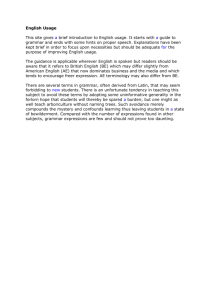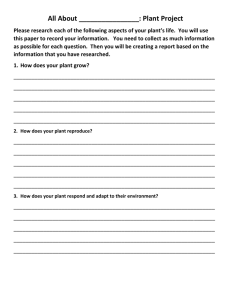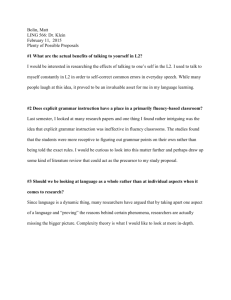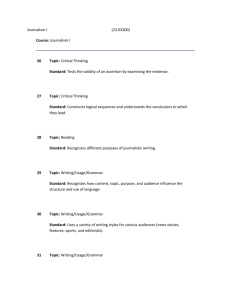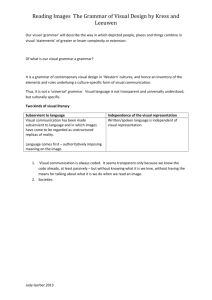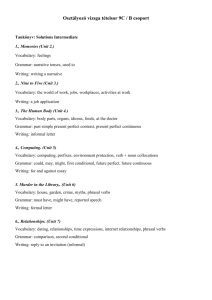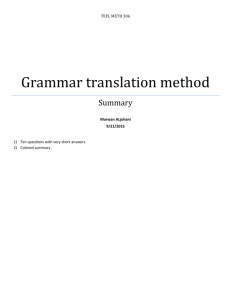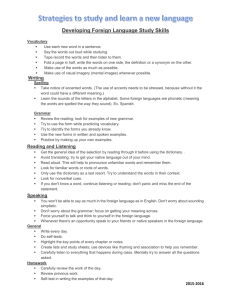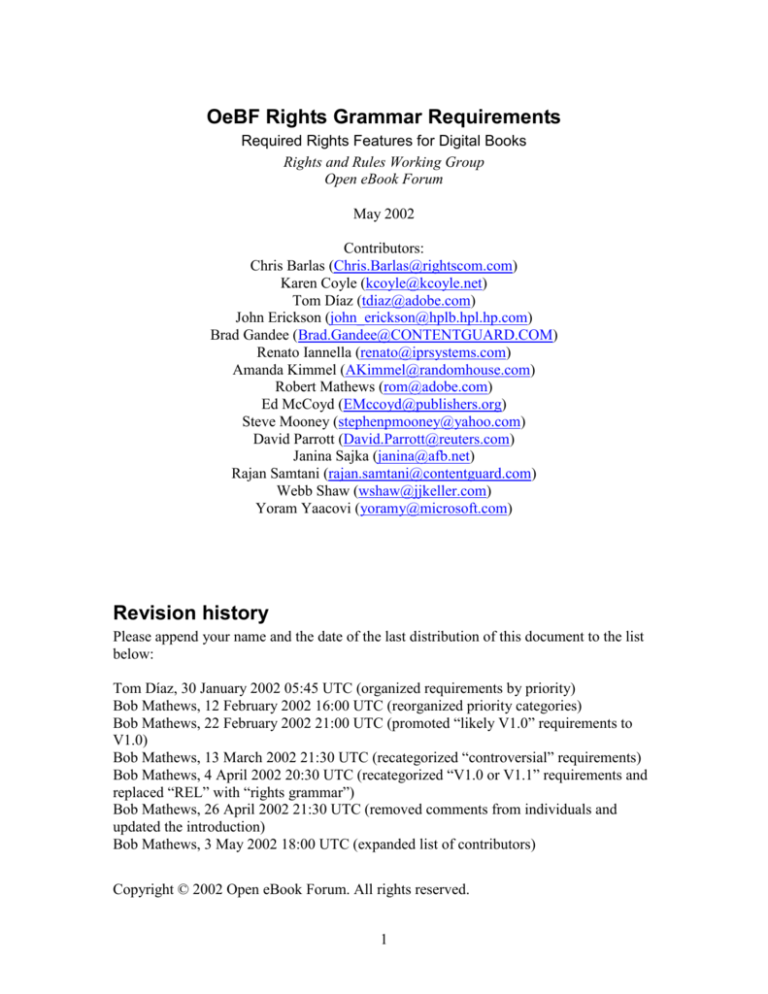
OeBF Rights Grammar Requirements
Required Rights Features for Digital Books
Rights and Rules Working Group
Open eBook Forum
May 2002
Contributors:
Chris Barlas (Chris.Barlas@rightscom.com)
Karen Coyle (kcoyle@kcoyle.net)
Tom Díaz (tdiaz@adobe.com)
John Erickson (john_erickson@hplb.hpl.hp.com)
Brad Gandee (Brad.Gandee@CONTENTGUARD.COM)
Renato Iannella (renato@iprsystems.com)
Amanda Kimmel (AKimmel@randomhouse.com)
Robert Mathews (rom@adobe.com)
Ed McCoyd (EMccoyd@publishers.org)
Steve Mooney (stephenpmooney@yahoo.com)
David Parrott (David.Parrott@reuters.com)
Janina Sajka (janina@afb.net)
Rajan Samtani (rajan.samtani@contentguard.com)
Webb Shaw (wshaw@jjkeller.com)
Yoram Yaacovi (yoramy@microsoft.com)
Revision history
Please append your name and the date of the last distribution of this document to the list
below:
Tom Díaz, 30 January 2002 05:45 UTC (organized requirements by priority)
Bob Mathews, 12 February 2002 16:00 UTC (reorganized priority categories)
Bob Mathews, 22 February 2002 21:00 UTC (promoted “likely V1.0” requirements to
V1.0)
Bob Mathews, 13 March 2002 21:30 UTC (recategorized “controversial” requirements)
Bob Mathews, 4 April 2002 20:30 UTC (recategorized “V1.0 or V1.1” requirements and
replaced “REL” with “rights grammar”)
Bob Mathews, 26 April 2002 21:30 UTC (removed comments from individuals and
updated the introduction)
Bob Mathews, 3 May 2002 18:00 UTC (expanded list of contributors)
Copyright © 2002 Open eBook Forum. All rights reserved.
1
Contents
1
2
Introduction ................................................................................................................. 7
Version 1.0 requirements ............................................................................................ 7
2.1
Social and legal issues ........................................................................................ 8
2.1.1
Required acknowledgments ........................................................................ 8
2.2
Attributes of the rights language ......................................................................... 8
2.2.1
Efficiency .................................................................................................... 8
2.2.2
Compatibility .............................................................................................. 8
2.2.3
Extensibility ................................................................................................ 8
2.2.4
Machine readability .................................................................................... 8
2.2.5
Metalanguage .............................................................................................. 8
2.2.6
Well-defined semantics ............................................................................... 8
2.2.7
Governance ................................................................................................. 9
2.2.8
Core primitives............................................................................................ 9
2.2.9
Users and roles ............................................................................................ 9
2.2.10
Identifiers for entities .................................................................................. 9
2.2.11
Identifiers for rights expressions ................................................................. 9
2.2.12
Usage and business models ......................................................................... 9
2.2.13
Definition of terms .................................................................................... 10
2.2.14
Data dictionary terms ................................................................................ 10
2.3
Identifiers and metadata .................................................................................... 10
2.3.1
Identifiers .................................................................................................. 10
2.3.2
Unambiguous identification ...................................................................... 10
2.3.3
Title and author ......................................................................................... 10
2.4
Digital objects ................................................................................................... 10
2.4.1
Object classes ............................................................................................ 10
2.4.2
Availability ............................................................................................... 10
2.4.3
Derivative works ....................................................................................... 11
2.5
Rights and obligations....................................................................................... 11
2.5.1
No rights unless explicitly granted ........................................................... 11
2.6
Constraints ........................................................................................................ 11
2.6.1
Conditions ................................................................................................. 11
2.6.2
Time-based conditions .............................................................................. 11
2.6.3
Conditions based on users or groups ........................................................ 11
2.6.4
Conditions based on reading systems ....................................................... 11
2.6.5
Count-based usage .................................................................................... 12
2.6.6
Fee-based usage ........................................................................................ 12
2.6.7
Portion-based usage .................................................................................. 12
2.7
Pricing models .................................................................................................. 12
2.7.1
Free objects ............................................................................................... 12
2.7.2
Unlimited use for a fee .............................................................................. 12
2.7.3
Tiered pricing based on quantity............................................................... 12
2.7.4
Pay per use ................................................................................................ 12
2.7.5
Subscription .............................................................................................. 12
2.7.6
Time-based pricing ................................................................................... 13
2.7.7
Metered pricing ......................................................................................... 13
2
2.7.8
Site licensing ............................................................................................. 13
2.8
Distribution and transfer ................................................................................... 13
2.8.1
Interoperability of transfer ........................................................................ 13
2.8.2
Ease of transfer ......................................................................................... 13
2.8.3
Direct sale by publishers ........................................................................... 13
2.8.4
Delegation ................................................................................................. 13
2.8.5
Limits to delegated rights.......................................................................... 13
2.8.6
Limiting distributor copies ........................................................................ 14
2.8.7
Required delivery schedules ..................................................................... 14
2.8.8
Delegation of perpetual rights ................................................................... 14
2.8.9
Content modification rules ........................................................................ 14
2.8.10
Content modification to overcome disability............................................ 14
2.8.11
Superdistribution ....................................................................................... 14
2.8.12
Preview ..................................................................................................... 14
2.8.13
Self-publishing .......................................................................................... 15
2.8.14
Updated versions ....................................................................................... 15
2.8.15
Library lending.......................................................................................... 15
2.8.16
Rights accompany content in end-user exchange ..................................... 15
2.8.17
End-user lending ....................................................................................... 15
2.8.18
End-user giving ......................................................................................... 15
2.9
Usage rights ...................................................................................................... 15
2.9.1
Use one copy at a time .............................................................................. 15
2.9.2
Cleartext copying ...................................................................................... 15
2.9.3
Display ...................................................................................................... 16
2.9.4
Printing...................................................................................................... 16
2.9.5
Offline use ................................................................................................. 16
2.9.6
Accessibility.............................................................................................. 16
2.10 Object management rights ................................................................................ 16
2.10.1
Digital copying.......................................................................................... 16
2.10.2
Library archival ......................................................................................... 16
2.11 Changing and adding rights .............................................................................. 16
2.11.1
Changing rights ......................................................................................... 16
2.11.2
Obtaining additional rights ....................................................................... 17
2.11.3
Updating rights.......................................................................................... 17
2.11.4
Renewing rights ........................................................................................ 17
2.11.5
Updating and renewing rights based on conditions .................................. 17
2.12 Accounting and privacy .................................................................................... 17
2.12.1
Privacy protection ..................................................................................... 17
2.12.2
Private rights and obligations.................................................................... 17
2.12.3
End-user access to rights ........................................................................... 17
2.12.4
Anonymous acquisition ............................................................................ 18
2.13 Trust model ....................................................................................................... 18
2.13.1
Authenticity and integrity of digital objects ............................................. 18
2.13.2
Authenticity of rights expressions ............................................................ 18
2.13.3
Authenticity of metadata ........................................................................... 18
2.13.4
Integrity of metadata ................................................................................. 18
3
3
V1.1 requirements ..................................................................................................... 18
3.1
Social and legal issues ...................................................................................... 19
3.1.1
Permission by contract .............................................................................. 19
3.1.2
Multiparty contracts .................................................................................. 19
3.1.3
Contract requiring permission for each use .............................................. 19
3.1.4
Acknowledgment of contract terms .......................................................... 19
3.1.5
Required legal notices ............................................................................... 19
3.1.6
Liability specifications .............................................................................. 19
3.2
Attributes of the rights language ....................................................................... 20
3.2.1
Customizability ......................................................................................... 20
3.2.2
Interoperability of operations .................................................................... 20
3.2.3
Predicate logic ........................................................................................... 20
3.2.4
Types of creations ..................................................................................... 20
3.2.5
Life cycle of digital objects....................................................................... 20
3.3
Identifiers and metadata .................................................................................... 20
3.3.1
Metadata .................................................................................................... 20
3.3.2
Processing information ............................................................................. 21
3.3.3
Additional metadata .................................................................................. 21
3.4
Digital objects ................................................................................................... 21
3.4.1
Composite objects ..................................................................................... 21
3.4.2
Separate rights for components of composite objects............................... 21
3.4.3
Combination rights.................................................................................... 21
3.4.4
Collections ................................................................................................ 21
3.4.5
Variable rights for composite objects ....................................................... 21
3.4.6
Bundling of objects ................................................................................... 22
3.4.7
Multiple versions ...................................................................................... 22
3.4.8
Object references ...................................................................................... 22
3.5
Rights and obligations....................................................................................... 22
3.5.1
Categorization of rights............................................................................. 22
3.5.2
Narrowing of rights ................................................................................... 22
3.5.3
Exclusive rights ......................................................................................... 22
3.5.4
Exceptions to rights................................................................................... 22
3.5.5
Sequences of rights ................................................................................... 22
3.5.6
Inheritance of rights .................................................................................. 23
3.5.7
Rights and interaction context .................................................................. 23
3.5.8
Obligations ................................................................................................ 23
3.5.9
Obligations as a consequence of rights exercise ....................................... 23
3.5.10
Ordering of obligations ............................................................................. 23
3.5.11
Extensible rights and obligations .............................................................. 23
3.5.12
Conflicting rights and obligations ............................................................. 23
3.5.13
Rights and obligations with and without state .......................................... 23
3.5.14
Relational binding ..................................................................................... 24
3.6
Constraints ........................................................................................................ 24
3.6.1
Territory-based conditions ........................................................................ 24
3.6.2
Conditions based on printing devices ....................................................... 24
3.6.3
Bundling of conditions .............................................................................. 24
4
3.6.4
Expiration based on conditions ................................................................. 24
3.6.5
Fallback conditions ................................................................................... 24
3.7
Pricing models .................................................................................................. 24
3.7.1
Tiered pricing based on quality................................................................. 24
3.7.2
Tiered pricing based on usage time .......................................................... 25
3.7.3
Pay per use followed by free access ......................................................... 25
3.7.4
User-based pricing .................................................................................... 25
3.7.5
Subscription with limited usage ................................................................ 25
3.7.6
Nested revenue models ............................................................................. 25
3.7.7
Changing pricing models .......................................................................... 25
3.7.8
Combining pricing models........................................................................ 25
3.8
Distribution and transfer ................................................................................... 26
3.8.1
Quality of service requirements ................................................................ 26
3.8.2
Branding requirements .............................................................................. 26
3.8.3
Bandwidth requirements ........................................................................... 26
3.8.4
Requirements for delivery media .............................................................. 26
3.8.5
Offline acquisition .................................................................................... 26
3.9
Usage rights ...................................................................................................... 26
3.9.1
Annotation................................................................................................. 26
3.9.2
Usage requirements ................................................................................... 26
3.10 Object management rights ................................................................................ 27
3.10.1
Backups ..................................................................................................... 27
3.10.2
Restoration of backups .............................................................................. 27
3.10.3
Deletion ..................................................................................................... 27
3.10.4
Multiple reading systems .......................................................................... 27
3.11 Changing and adding rights .............................................................................. 27
3.12 Accounting and privacy .................................................................................... 27
3.12.1
Collecting accounting information ........................................................... 27
3.12.2
Payment rules ............................................................................................ 28
3.12.3
Usage tracking and reporting .................................................................... 28
3.12.4
Confidential sources of content ................................................................ 28
3.12.5
Required identification.............................................................................. 28
3.13 Trust model ....................................................................................................... 28
4 Indefinitely deferred requirements ............................................................................ 28
4.1
Social and legal issues ...................................................................................... 28
4.1.1
First sale .................................................................................................... 28
4.1.2
Fair use ...................................................................................................... 29
4.1.3
Expiration of copyright ............................................................................. 29
4.1.4
Export restrictions ..................................................................................... 29
4.1.5
No nation favored ..................................................................................... 29
4.1.6
Enforcement of national laws ................................................................... 29
4.1.7
European Union Copyright Directive ....................................................... 29
4.1.8
European Union data protection ............................................................... 30
4.1.9
European Union distance selling .............................................................. 30
4.2
Attributes of the rights language ....................................................................... 30
4.2.1
Standards ................................................................................................... 30
5
4.2.2
Default schema with local extensions ....................................................... 30
4.2.3
Alternative predicate expressions ............................................................. 30
4.2.4
Namespaces............................................................................................... 30
4.2.5
Abstract terms in the core ......................................................................... 31
4.2.6
Element types and hierarchy ..................................................................... 31
4.2.7
Data dictionary references ........................................................................ 31
4.2.8
Data dictionaries as digital objects ........................................................... 31
4.3
Identifiers and metadata .................................................................................... 31
4.3.1
“Fuzzy” identification ............................................................................... 31
4.3.2
Identification by object attributes ............................................................. 31
4.3.3
Identification by content attributes ........................................................... 32
4.3.4
Size and efficiency .................................................................................... 32
4.4
Digital Objects .................................................................................................. 32
4.4.1
Interoperability of content......................................................................... 32
4.4.2
Object data types ....................................................................................... 32
4.5
Rights and obligations....................................................................................... 32
4.5.1
Expression evaluation services ................................................................. 32
4.5.2
Conversations ............................................................................................ 32
4.6
Constraints ........................................................................................................ 33
4.6.1
Environmental conditions ......................................................................... 33
4.7
Pricing models .................................................................................................. 33
4.7.1
Sponsored pricing ..................................................................................... 33
4.7.2
No price distinction based on disability .................................................... 33
4.7.3
Refunds ..................................................................................................... 33
4.8
Distribution and transfer ................................................................................... 33
4.8.1
Age-based restrictions on queries ............................................................. 33
4.8.2
Load-based restrictions on queries............................................................ 33
4.8.3
Restrictions on records retrieved .............................................................. 34
4.8.4
Restrictions on data elements retrieved .................................................... 34
4.8.5
Subordinate rights ..................................................................................... 34
4.8.6
End-user trades with user identification ................................................... 34
4.9
Usage rights ...................................................................................................... 34
4.9.1
No rights distinction based on disability................................................... 34
4.9.2
No usability distinction based on disability .............................................. 34
4.9.3
Restrictions on purpose of use .................................................................. 34
4.10 Object management rights ................................................................................ 35
4.10.1
File management rights ............................................................................. 35
4.10.2
Configuration rights .................................................................................. 35
4.10.3
Object retention rules ................................................................................ 35
4.11 Changing and adding rights .............................................................................. 35
4.12 Accounting and privacy .................................................................................... 35
4.12.1
Privacy obligations.................................................................................... 35
4.13 Trust model ....................................................................................................... 35
5 Definitions................................................................................................................. 35
6
1
Introduction
In June 2001, the Rights and Rules Working Group of the Open eBook Forum (OeBF)
issued a call for requirements for digital rights management (DRM). By September 2001,
the working group had received nearly 400 requirements. Of these requirements, all but
about 25 addressed or had implications for a rights grammar.
At a meeting on September 11, 2001, the Rights and Rules Working Group agreed to
address requirements related to a rights grammar before addressing other requirements.
The working group established a Rights Grammar Subgroup to receive the normalized
requirements, assign priorities to the requirements, and to prepare a coordinated
requirements statement for the rights grammar. It is also intended as a possible
submission to the MPEG-21 group.
The requirements introduced by the acronym “DRM” are not properties of the rights
grammar but still are of interest to OeBF stakeholders and should be considered for OeBF
DRM standards. These include requirements related to enforcement of rights expressions
by products, requirements for a trust model, and so on. This compilation includes some
requirements of that kind. In addition, a separate document, compiled in October 2001,
describes requirements for a trust model and will be reviewed separately.
The Rights Normalization Subgroup prepared the document “Requirements for a Rights
Expression Language,” which served as source material for this draft specification. The
subgroup first deferred for later consideration those requirements that did not clearly
relate to a rights grammar. The subgroup then identified duplication and overlap among
the remaining requirements. In some cases the subgroup split submitted requirements into
multiple discrete requirements. The subgroup then created new requirements in
normalized form, linking each to one or more of the submitted requirements. Finally, the
subgroup placed the normalized requirements into broad categories.
The Rights Grammar Subgroup began with the set of normalized requirements and,
through a series of discussions, proposed the priority ordering presented in this document.
The subgroup divided all normalized requirements into the following categories:
Version 1.0 requirements
Version 1.1 requirements
Indefinitely deferred requirements
Beneath each requirement is a list of one or more numbers. These numbers are the IDs in
the OeBF requirements database of the original stakeholder requirements to which each
normalized requirement is linked.
2
Version 1.0 requirements
These received a “must” from at least the content provider representatives to the Rights
Grammar subgroup. Most of the requirements in this category received a “must” from
most or all respondents in the group and therefore represent the requirements that the
subgroup considered to be the most urgent.
7
The requirements in this category are therefore required to be met by functional
specifications for products that comply with an OeBF Rights Grammar specification,
version 1.0.
2.1
2.1.1
Social and legal issues
Required acknowledgments
DRM shall allow for required acknowledgements (for example, copyright notices or
corporate logos) to be specified as a consequence of using data.
10365
Rights Grammar Subgroup: Note wording change.
2.2
2.2.1
Attributes of the rights language
Efficiency
DRM shall be sufficiently efficient that performance does not have noticeable delays for
end users and time-critical machine processing is not impaired.
10137, 10372
2.2.2
Compatibility
DRM shall provide that future versions of the rights grammar are backward compatible
with older versions.
10141
2.2.3
Extensibility
The rights grammar shall be extensible and allow alternative schemas wherever sensible
to meet the future needs of the digital content industry.
10199, 10219, 10303
2.2.4
Machine readability
The rights grammar shall be machine-readable.
10217
2.2.5
Metalanguage
The rights grammar shall be defined in an open, standard metalanguage.
10224
2.2.6
Well-defined semantics
The rights grammar shall have useful, concise, unambiguous, and easily understandable
semantics and predictable effects.
8
10225
2.2.7
Governance
The rights grammar shall be specified, documented, and otherwise managed in a way that
meets general coordination requirements of industry standards.
10226
2.2.8
Core primitives
The rights grammar shall define a minimal core set of primitive constructs from which all
other expressions can be constructed or derived. For example, instead of defining per-perview, rent-to-own, and other such models, the core shall provide the fundamental
building blocks to link obligations (e.g., payment) to actions, to allow obligations to
repeat according to various criteria, provide metering syntax, etc.
10300
2.2.9
Users and roles
The rights grammar shall support the articulation of roles undertaken by users. Example:
User may be associated with the role of "illustrator" for an identified digital object.
10200, 10201, 10330
2.2.10 Identifiers for entities
The rights grammar shall support an open standard identification system for entities in
the model. Example: ISO TC46 SC9 identification systems, open standards based on the
URI standard (RFC2396)
10202
2.2.11 Identifiers for rights expressions
The rights grammar shall provide mechanisms to unambiguously and universally identify
rights expressions written in the language and allow these expressions to be treated as
digital objects in their own right.
10222, 10228, 10315
2.2.12 Usage and business models
The rights grammar shall enable the description of rights, permissions, conditions and
obligations to support existing usage and business models and shall not constrain future
models.
10204, 10419
9
2.2.13 Definition of terms
The rights grammar shall support the separation of the semantics from any syntactical
encodings. Terms can be defined with a formal definition, name, comment and usage
notes.
10208
2.2.14 Data dictionary terms
The rights grammar shall support a hierarchy of data dictionary terms such that local
definitions may be referenced within closed communities. Default and user-specified
augmentation and over-ride semantics are required.
10336
2.3
Identifiers and metadata
2.3.1
Identifiers
The rights grammar shall use standard identifiers (such as ISBN and DOI) for digital
objects.
10091, 10159.1, 10229, 10329
2.3.2
Unambiguous identification
Metadata for a digital object in the DRM context shall unambiguously identify a work for
both supplier and recipient in a transaction.
10159
2.3.3
Title and author
Metadata for a digital object in the DRM context shall include at least the title and
originator of the work.
10159.2
2.4
2.4.1
Digital objects
Object classes
It shall be possible to construct a single rights expression to apply to a class of digital
objects. The rights grammar shall therefore support class definitions and affiliations.
10322
2.4.2
Availability
The rights grammar shall support standard mechanisms to indicate where digital objects
are available for retrieval or access.
10235
10
2.4.3
Derivative works
DRM shall provide mechanisms to allow the rights holder to control whether and how
derivative works can be created from a digital object.
10075, 10241, 10319
2.5
2.5.1
Rights and obligations
No rights unless explicitly granted
DRM shall have default semantics in the case when no rights and obligations expressions
are currently applicable to a digital object. For example, each component in the exchange
of a digital object shall deny rights for the digital object unless the rights are explicitly
granted. A mechanism to override the default shall be made available in the rights
grammar.
10156, 10325
2.6
2.6.1
Constraints
Conditions
The rights grammar shall allow for the specification of a set of conditions that must be
fulfilled before a right (or set of rights) can be exercised.
10309
2.6.2
Time-based conditions
The rights grammar shall support unambiguous specifications of time to allow for
commerce across time zones and rights expression based on time specifications such as
specific times, fixed intervals, sliding intervals and metered intervals.
10056, 10246, 10341, 10399
2.6.3
Conditions based on users or groups
The rights grammar shall support rights expressions for different individual users or for
different groups of users. Individual user rights may differ from those granted to a group
of users.
10061, 10418, 10466
2.6.4
Conditions based on reading systems
The rights grammar shall support the expression of rights and rules associated with the
capabilities of specific reading systems or other applications.
10062, 10407
11
2.6.5
Count-based usage
The rights grammar shall provide mechanisms to specify conditions based on the number
of times a right can be exercised.
10247
2.6.6
Fee-based usage
The rights grammar shall support the specification of fees in industry standard terms.
10248
2.6.7
Portion-based usage
The rights grammar shall provide mechanisms to specify information about portions of
digital objects, including both identified portions and generic portions (such as “any 5
pages”), in order to support limiting rights to these certain portions.
10253, 10385
2.7
2.7.1
Pricing models
Free objects
The rights grammar shall support distribution and management of free digital objects.
10047, 10397
2.7.2
Unlimited use for a fee
The rights grammar shall support specifying a price, including a price of “free”, for
unlimited usage of a digital object.
10262, 10397.2
2.7.3
Tiered pricing based on quantity
The rights grammar shall support specifying conditions (such as different pricing levels)
based on the number of copies of a work requested.
10048, 10265, 10397.6
2.7.4
Pay per use
The rights grammar shall support payment of a fee for each use of a digital object either
online or offline.
10050, 10050.1, 10266, 10397.1
2.7.5
Subscription
The rights grammar shall support subscription-based pricing and access to content.
10052.1, 10267
12
2.7.6
Time-based pricing
The rights grammar shall support time-based pricing rules for digital objects.
10056.1
2.7.7
Metered pricing
The rights grammar shall support metered pricing.
10057
2.7.8
Site licensing
The rights grammar shall support digital object access and use under a site license.
10271
2.8
Distribution and transfer
2.8.1
Interoperability of transfer
DRM shall support the transfer of a digital object and its associated rights between
components made by different technology providers.
10110, 10205
2.8.2
Ease of transfer
DRM shall make buying and borrowing electronic publications easier than buying and
borrowing the equivalent publications in print.
10136
2.8.3
Direct sale by publishers
DRM shall allow publishers to sell digital objects to end users.
10125
2.8.4
Delegation
DRM shall support the delegation of rights and rules associated with digital objects. For
example, the rights grammar will provide means for publishers to give distributors and
sellers the right to sell digital objects to sellers, libraries, and end users.
10071, 10126
2.8.5
Limits to delegated rights
DRM shall support the enforcement of limits associated with delegation of rights, where
a third party could only grant rights to individuals according to limits established by the
rights holder during the initial acquisition of the digital object by that third party.
10071.1
13
2.8.6
Limiting distributor copies
The rights grammar shall support specifying a maximum number of copies that a
distributor can make of a work for further transmission or sale.
10276
2.8.7
Required delivery schedules
Provision shall be made in the rights grammar so that content originators can specify on
their downstream partners the requirement for fair delivery schedules, including time
windows for delivery or release of content at specific times.
10367, 10368, 10398
2.8.8
Delegation of perpetual rights
The rights grammar shall support the delegation of perpetual rights associated with a
digital object to a consumer.
10098
2.8.9
Content modification rules
The rights grammar shall provide syntax for rules defining how agents may alter digital
objects subsequent to publication.
10383
2.8.10 Content modification to overcome disability
DRM shall allow trusted agencies to modify existing content for the purpose of enabling
persons with disabilities to exercise the rights granted. Example: An agency might need
to alter an audio publication to provide additional navigational features such as track
announcements, page numbers, the bibliography, or the index.
10435
2.8.11 Superdistribution
DRM shall support superdistribution to enable recipients of digital objects to purchase or
legally obtain a license for the object. The license can be for any set of rights that the
content owner chooses to grant.
10070, 10124, 10275
2.8.12 Preview
DRM shall support preview of the digital object, in whole or in part, free or for
compensation.
10145, 10264, 10443
14
2.8.13 Self-publishing
DRM shall support self-publishing by authors. This support shall include a range of
security options, among which is the distribution of unprotected works.
10113
2.8.14 Updated versions
DRM shall provide means of making updated versions of a literary work available to end
users.
10123.1
2.8.15 Library lending
DRM shall allow libraries to lend digital objects to end users and to designate the
duration or expiration times of the loans.
10130, 10274, 10421
2.8.16 Rights accompany content in end-user exchange
When two end users exchange a digital object, the rights to the digital object shall be
exchanged along with the content.
10441
2.8.17 End-user lending
DRM shall allow an end user who has purchased a digital object to lend it to another end
user. During the period of the loan, the lender shall not have access to the digital object.
10040, 10067, 10138, 10239, 10425
2.8.18 End-user giving
DRM shall allow an end user who has acquired a digital object to give it to another end
user. The giver shall relinquish all rights to access and use of the digital object.
10069, 10138
2.9
2.9.1
Usage rights
Use one copy at a time
DRM shall ensure that an end user who purchases one copy of a digital object has rights
to use only one copy of the object at any time.
10115
2.9.2
Cleartext copying
DRM shall allow rights holders to control whether or not authorized users can make
unprotected/unmanaged copies of originally protected/managed digital objects.
15
10078
2.9.3
Display
The rights grammar shall provide mechanisms to express display rights relative to all or a
portion of the digital object.
10240.1
2.9.4
Printing
The rights grammar shall provide mechanisms to express print rights relative to all or a
portion of the digital object.
10076, 10240
2.9.5
Offline use
DRM shall support offline enforcement of rights and rules associated with digital objects.
10097
2.9.6
Accessibility
The rights grammar shall allow for alternative usage permissions or constraints for digital
objects to meet the needs of communities with special needs.
10214, 10467
2.10 Object management rights
2.10.1 Digital copying
DRM shall support the ability to make copies of the digital object. The rights grammar
shall allow the rights holder to establish rules that are specific to copies made.
10072
2.10.2 Library archival
DRM shall allow libraries and cultural heritage institutions to archive digital objects.
10132, 10469
2.11 Changing and adding rights
2.11.1 Changing rights
DRM shall provide mechanisms that express under what conditions rights expressions
can be altered or augmented. Examples:
1) Rights holder may want to change price.
2) Retailer needs to add markup to distributor’s price.
3) Consumer may want to buy additional rights to a digital object.
16
10066, 10245, 10343
2.11.2 Obtaining additional rights
DRM shall allow consumers to obtain additional rights for a digital object for which they
already have certain rights (or none at all) either individually or through a group
association. Support shall be provided in the rights grammar for specifying how licenses
are thus obtained, with additional support for context-based variations.
10065, 10348
2.11.3 Updating rights
DRM shall support updating rights and obligations during their lifetime.
10343
2.11.4 Renewing rights
DRM shall support renewing rights and obligations once their lifetime has expired (or
have been otherwise revoked).
10344
2.11.5 Updating and renewing rights based on conditions
The rights grammar shall provide for cases where rights and obligations require update or
renegotiation when specified trigger conditions are met.
10345
2.12 Accounting and privacy
2.12.1 Privacy protection
DRM shall protect the privacy of end users. It shall allow the end user to control the
dissemination of his private information and include hooks to make reference to privacy
specification protocols such as P3P wherever possible.
10100, 10142, 10413
2.12.2 Private rights and obligations
The rights grammar shall provide a mechanism for specifying that the details of rights
and obligations expressions are private and exclusive to the subjects of those expressions.
10351
2.12.3 End-user access to rights
DRM shall allow end users to access the rights and rules associated with a digital object.
10100.1, 10463
17
2.12.4 Anonymous acquisition
DRM shall support acquisition of rights and rules associated with digital objects where
the consumer's identity is not required.
10102, 10157
2.13 Trust model
2.13.1 Authenticity and integrity of digital objects
DRM shall ensure that digital objects are not tampered with or altered after they are
published, except insofar as the rights holder allows modification.
10083, 10144, 10233, 10412
2.13.2 Authenticity of rights expressions
DRM shall allow for authentication of expressions and documents written in the
language.
10223
2.13.3 Authenticity of metadata
DRM shall support verification of authenticity of parts or all of metadata associated with
a digital object.
10092.1
2.13.4 Integrity of metadata
DRM shall protect the integrity of parts or all of metadata associated with a digital object.
10092.2
3
V1.1 requirements
These requirements are recommended for deferral and reconsideration in version 1.1. If
representatives on the Rights Grammer Subgroup interested in content (ALA, AAP,
Accessibility SIG, et al.) specifically recommended deferring a requirement to version
1.1, the subgroup gave that recommendation extra weight.
The requirements in this category are therefore possibly required to be met by functional
specifications for products that comply with an OeBF Rights Grammar specification,
v1.1.
Version 1.1 is a hypothetical revision of the OeBF Rights Grammar standard. It would be
issued after version 1.0 not so much because more requirements gathering was needed
but because, for example:
More research is needed by technology companies or
The features are not needed soon; the requirements reflect business models that
publishers are interested in but not practicing today.
18
Version 1.1 requirements should be briefly documented in the version 1.0 standard as
likely extensions, as a guide to implementers. Ideally, the guide is so specific as to
suggest, “If you’re going to implement a feature in this area, do it this way, because that
is the likely standard.”
3.1
3.1.1
Social and legal issues
Permission by contract
The rights grammar shall support expression of permission by contract, in a chosen
language of contract, which may be a formal XML-based standard or informal natural
language.
10207, 10392
3.1.2
Multiparty contracts
The rights grammar shall make provision for multiparty contracts.
10395
3.1.3
Contract requiring permission for each use
A special case of contract establishment is one that requires a value-chain participant to
seek explicit permission for each and every use of a digital object. The rights grammar
shall provide a method for describing this case and all its attributes.
10396
3.1.4
Acknowledgment of contract terms
The rights grammar shall provide syntax for specifying that (and the method by which) a
publisher requires explicit acknowledgement of contractual terms before access to an
object is granted.
10393, 10394
3.1.5
Required legal notices
The rights grammar shall make provision to describe requirements on all participants in
the value chain (including rendering tools used by the end-consumer) on the placement of
legal notices alongside content.
10366
3.1.6
Liability specifications
It shall be possible within the rights grammar to describe liability incumbent upon value
chain participants if they agree to interact with digital objects in a particular fashion.
10380
19
3.2
3.2.1
Attributes of the rights language
Customizability
The rights grammar shall be customizable for specialized applications within the current
version of the language.
10220
3.2.2
Interoperability of operations
The rights grammar shall support interoperable DRM services, such as clearinghouse
rights authentication, transactions processing, and secure storage.
10221
3.2.3
Predicate logic
The rights grammar shall support (possibly via extensibility mechanisms) arbitrarily
complex predicate logic.
10333
Rights Grammar Subgroup: We must discuss this requirement at the V1.0 design and
implementation phase.
3.2.4
Types of creations
The rights grammar shall support the description of rights associated with all types of
creations. Note: This includes abstractions, expressions, manifestations and artifacts.
Example: To support the description of rights in musical works, performances of musical
works, sound recordings and physical sound carriers.
10203, 10216
3.2.5
Life cycle of digital objects
The rights grammar shall provide a set of default mechanisms to express all essential
types and modes of usage and consumption of digital objects throughout their life cycles,
including creation, publishing, distribution, consumption, and invalidation/disposal.
10206, 10218, 10236, 10388
3.3
3.3.1
Identifiers and metadata
Metadata
DRM shall provide mechanisms to reference metadata as part of the rights grammar,
make reference to external content metadata and include existing content metadata. It
shall support the enforcement of metadata where all or part of the metadata may be
controlled by DRM.
10092, 10230
20
3.3.2
Processing information
Metadata for a digital object in the DRM context shall include enough information to
allow a component that receives the object to process it correctly. For a reading system
for electronic publications, this information includes the work’s content format and
information about how the work is encrypted, such as encryption algorithm, method, and
key length.
10160
3.3.3
Additional metadata
DRM shall provide means for associating a digital object with large bodies of metadata
about the object.
10162
3.4
3.4.1
Digital objects
Composite objects
DRM shall support a combination of digital objects where the objects can be of different
media types, including sound, animation, video and electronic text. DRM shall support
rights and rules for the entire set of objects and/or for specific objects within the set.
10051, 10114, 10231, 10370
3.4.2
Separate rights for components of composite objects
The rights grammar shall support specifying different rights, conditions, and obligations
to individual components of a composite work, as well as to the entire composite work.
10269
3.4.3
Combination rights
DRM shall allow the rights holder to control whether a digital object can be combined in
any way (for example, by a third party content aggregator) with and into other digital
objects.
10073, 10381
3.4.4
Collections
The rights grammar shall provide mechanisms to reference collections of digital objects.
10232
3.4.5
Variable rights for composite objects
The rights grammar shall support expression of rights and rules which may vary
according to the relationships between and/or navigation through a collection of digital
objects that constitute a larger digital object.
10048.1, 10312
21
3.4.6
Bundling of objects
The rights grammar shall support bundling of digital objects (for pricing or rights
purposes) independent of the channel, delivery method, or time frame.
10060, 10324
3.4.7
Multiple versions
The rights grammar shall provide means of distinguishing versions of a literary work.
10123
3.4.8
Object references
It shall be possible within the rights grammar to specify rules regarding how a digital
object may be referenced by other digital objects.
10390
3.5
3.5.1
Rights and obligations
Categorization of rights
The rights grammar shall enable the organization of rights into categories.
10237
3.5.2
Narrowing of rights
The rights grammar shall support the expression of narrowing of rights.
10211
3.5.3
Exclusive rights
The rights grammar shall support the expression of exclusive rights.
10212
3.5.4
Exceptions to rights
The rights grammar shall support the expression of exceptions to rights.
10213
3.5.5
Sequences of rights
The rights grammar shall allow for the specification of a set of rights that exist according
to a total or partial sequence. Transition between rights in the sequence may be triggered
by time-based or other events.
10311
22
3.5.6
Inheritance of rights
The rights grammar shall allow for the specification of inheritance semantics to define
how rights are transferred between associated digital objects.
10313
3.5.7
Rights and interaction context
Provision shall be made in the rights grammar for the formation of rights expressions in
terms of attributes of the context in which the interaction between users and digital
objects is taking place.
10331, 10350
3.5.8
Obligations
The rights grammar shall provide mechanisms to express a set of obligations in order to
support building and deploying DRM solutions, systems and services. Examples are:
Watermarking, Usage Tracking, Legal Notices.
10257
3.5.9
Obligations as a consequence of rights exercise
The rights grammar shall allow for the specification of a set of obligations that are a
consequence of exercising a right (or set of rights).
10308
3.5.10 Ordering of obligations
The rights grammar shall allow for the specification of a set of obligations that must be
fulfilled in order.
10310
3.5.11 Extensible rights and obligations
The rights grammar shall be sufficiently extensible to allow for the description of all
possible models of rights and obligations transfer between digital objects.
10314
3.5.12 Conflicting rights and obligations
DRM shall have default semantics in the case when rights and obligations expressions are
in conflict. A mechanism for globally overriding the default conflict-resolution scheme
shall also be provided.
10326
3.5.13 Rights and obligations with and without state
It shall be possible to rights and obligations expressions with and without state.
23
10354
3.5.14 Relational binding
An electronic contract may wish to bind together numerous rights and data entities in a
relational manner. Provision shall exist in the rights grammar to support this.
10321
3.6
Constraints
3.6.1
Territory-based conditions
The rights grammar shall support industry-standard mechanisms to reference physical
regions, areas, and locations as well as digital domains, networks, and systems.
10053, 10252, 10268, 10400, 10401, 10456
3.6.2
Conditions based on printing devices
The rights grammar shall support the expression of rights and rules associated with the
capabilities of specific printing devices.
10077
3.6.3
Bundling of conditions
The rights grammar shall provide mechanisms to bundle conditions and reference the
bundle as a single entity.
10255
3.6.4
Expiration based on conditions
In addition to temporal constraints on the lifetime of rights and obligations expressions,
arbitrary trigger conditions shall be allowed to expire an expression.
10347
3.6.5
Fallback conditions
If a rights set denies access to one class of data, the rights grammar shall allow a
publisher to specify another class of data to which the rights apply.
10349
3.7
Pricing models
3.7.1
Tiered pricing based on quality
The rights grammar shall support specifying conditions (such as different pricing levels)
based on the quality of different versions of a same work offered.
10265.1
24
3.7.2
Tiered pricing based on usage time
The rights grammar shall support specifying conditions (such as different pricing levels)
based on the length of time to use a work.
10048.2, 10265.2
3.7.3
Pay per use followed by free access
The rights grammar shall support payment of a fee for each use of a digital object up to a
limit and then switch to free access for allowed uses (“rent-to-own”).
10397.1
3.7.4
User-based pricing
The rights grammar shall support user-based pricing levels for different individual users
or for different groups of users.
10270
3.7.5
Subscription with limited usage
The rights grammar shall support the consumer’s payment of a minimum up-front charge
on a subscription basis. The subscription expires when either a time limit expires or a
permitted number of uses or amount of usage time is exceeded. Subsequent uses incur
separate per-use charges.
10397.4
3.7.6
Nested revenue models
The rights grammar shall support specifying payments for Digital Object usage in terms
of percentages of previous transactions. Example: Pay to B 2% of how much is paid to A.
10278
3.7.7
Changing pricing models
DRM shall support changing between pricing models that are allowed by the rights and
rules enforced.
10052
3.7.8
Combining pricing models
DRM shall support the combining of different pricing options for rights and rules
associated with digital objects.
10055
25
3.8
Distribution and transfer
3.8.1
Quality of service requirements
The rights grammar shall allow the specification of minimum levels of quality of service
to be met by downstream distributors of content.
10355
3.8.2
Branding requirements
The rights grammar shall make provision to describe requirements on distributors and
other value-chain participant for branding content. Metadata constructs for describing the
branding material (e.g., logos) are required.
10364
3.8.3
Bandwidth requirements
It shall be possible to specify in the rights grammar minimum bandwidth to be operated
by downstream distributors and channel partners when they are responsible for
downstream real-time data delivery.
10369
3.8.4
Requirements for delivery media
The rights grammar shall support the specification of allowed (or disallowed) media via
which content may be delivered.
10378
3.8.5
Offline acquisition
DRM shall support acquisition of rights to a digital object while offline with
asynchronous clearance of that transaction.
10097.1
3.9
3.9.1
Usage rights
Annotation
The rights grammar shall allow for rules governing the manner in which annotations may
be added to an original object. It shall be possible for the rules to describe how
annotations are presented and distinguished from the original content.
10384
3.9.2
Usage requirements
It shall be possible to specify in the rights grammar the manner in which content is to be
used, such as by the application of style guides and templates to define “look and feel”.
26
10360
3.10 Object management rights
3.10.1 Backups
DRM shall allow consumers to create backups of digital objects which have rights and
rules enforced by the DRM. Each backup copy shall itself be controlled by the same
rights and rules that pertain to the original digital object.
10084, 10140
3.10.2 Restoration of backups
DRM shall allow consumers to restore backup copies of digital objects which have rights
and rules enforced by the DRM. Each restored backup copy shall itself be controlled by
the same rights and rules which pertain to the original digital object.
10086
3.10.3 Deletion
DRM shall support the right to delete a digital object. The rules shall extend to the
manner of destruction of the object, which will include such requirements as caching a
deleted object within a retrieval area until a condition is met (timeout, flushing of the
cache, etc).
10085, 10387
3.10.4 Multiple reading systems
DRM shall allow an end user to transfer a digital object to any reading system that the
user owns and exercise all rights granted to the user on any such reading system. DRM
shall allow any conversion of the digital object’s content format that is necessary to
transfer the digital object to and exercise rights on another reading system that the user
owns.
10087, 10087.1, 10421.1, 10425.1, 10445
3.11 Changing and adding rights
3.12 Accounting and privacy
3.12.1 Collecting accounting information
DRM shall support collection of accounting information throughout the value chain for
commercial and non-commercial distribution.
10065.1, 10120, 10363
27
3.12.2 Payment rules
The rights grammar shall make provision for rules specifying when particular actions
must be completed. For example, payment shall be made to rights holders within 30 days.
10065.2, 10373
3.12.3 Usage tracking and reporting
The rights grammar shall provide the mechanisms to express the requirement for usage
tracking and the conditions that apply. DRM shall enforce the collection of usage metrics
throughout a value chain.
10042, 10099, 10099.1, 10122, 10258, 10362
3.12.4 Confidential sources of content
The rights grammar shall make it possible to specify confidentiality clauses that require
downstream contributors to respect the confidentiality of the source of the content or of
organizations.
10415, 10416, 10417
3.12.5 Required identification
The rights grammar shall provide syntax to require that data delivered to a recipient at
any stage in a distribution chain be marked in some manner to identify the recipient.
10357
Rights Grammar Subgroup: Note wording change.
3.13 Trust model
4
Indefinitely deferred requirements
Requirements in this category are not likely to be considered for either version 1.0 or
version 1.1. Requirements may appear in this category for a number of reasons:
Some are outside the scope of the working group or its mission
Some are specific to particular countries or regions
Some are sufficiently covered by requirements for version 1.0 or 1.1
Some pertain more to design and implementation than to expression of requirements
Nonetheless, the working group may reconsider some of these requirements in the future.
4.1
4.1.1
Social and legal issues
First sale
DRM shall support the “first sale” principle to the extent that “first sale” is supported by
applicable copyright laws. For example, in some circumstances “first sale” may permit
purchasers of digital objects to use them on multiple reading systems, resell them, lend
28
them, or give them to others without paying a fee to the copyright holder or breaking any
laws.
10425, 10425.1, 10425.2, 10464
4.1.2
Fair use
DRM shall allow end users to make “fair use” of digital objects to the extent that “fair
use” is allowed by applicable copyright laws. For example, in some circumstances “fair
use” may include copying and printing portions of a digital object, or it may include the
right to obtain an unprotected version of the work upon completing a registration
procedure.
10031, 10131, 10424, 10450.1, 10465
4.1.3
Expiration of copyright
When copyright expires on a digital objects and it legally moves into the public domain,
the digital object shall then be accessible by the public. At this point, anyone shall be
allowed to read, copy, and convert the digital object without paying a fee to the (former)
copyright holder, and without committing a felony.
10422, 10468
4.1.4
Export restrictions
DRM shall not require levels of encryption strength or other technology that would
prevent components from being legally exported from one country to another.
10158, 10453
4.1.5
No nation favored
DRM shall not innately favor one national jurisdiction over another.
10454
4.1.6
Enforcement of national laws
DRM shall be able to identify content with sufficient precision in order to enable national
laws on content, including laws protecting minors, to be enforced.
10455
4.1.7
European Union Copyright Directive
DRM shall take into account recent EU legislation, specifically the "EU Directive on
Certain Aspects of Copyright and Related Rights in an Information Society" (known
generally as "the EU Copyright Directive"
http://eurorights.org/eudmca/CopyrightDirective.html).
10450
29
4.1.8
European Union data protection
DRM shall take into account the EU legislation on data protection, as given in the
European Directive on Data Protection.
10451
4.1.9
European Union distance selling
DRM shall take into account the EU rules on distance selling, as given in the Directive on
the Protection of Consumers in respect of Distance Contracts. In the UK, this was enacted
as the Consumer Protection (Distance Selling) Regulations 2000
(http://www.hmso.gov.uk/si/si2000/20002334.htm). The Act specifies what has to be said
about any product that is sold online, and the rights of the consumer to cancel the contract
of purchase and be reimbursed.
10452
4.2
4.2.1
Attributes of the rights language
Standards
The rights grammar shall support requirements from standardization activities, including
MPEG IPMP, DOI, INDECS, W3C, cIDf, and others.
10440
4.2.2
Default schema with local extensions
The rights grammar shall be defined in terms of an extensible core and a default schema
which may be extended or overridden on a local basis.
10301
Rights Grammar Subgroup: We must discuss this requirement at the V1.0 design and
implementation phase.
4.2.3
Alternative predicate expressions
For full flexibility, it shall be possible to specify in the rights grammar alternative
predicate expressions as per a rule-based system.
10334
4.2.4
Namespaces
The rights grammar shall support the concept of namespaces in all areas where
extensibility might lead to name or syntax clashes.
10335
Rights Grammar Subgroup: We must discuss this requirement at the V1.0 design and
implementation phase.
30
4.2.5
Abstract terms in the core
The core rights grammar shall contain only abstract terms, with concrete enumerations
placed in either the default or alternative schemas.
10302
Rights Grammar Subgroup: We must discuss this requirement at the V1.0 design and
implementation phase.
4.2.6
Element types and hierarchy
The rights grammar shall allow definition of abstract and concrete elements and shall
allow for a hierarchy of elements.
10209
Rights Grammar Subgroup: We must discuss this requirement at the V1.0 design and
implementation phase.
4.2.7
Data dictionary references
The rights grammar shall provide facilities to reference data dictionary definitions from
any source including dynamic sources such as LDAP directories and relational databases
which may require dynamic resolution.
10337
4.2.8
Data dictionaries as digital objects
Data dictionaries are digital objects and shall therefore be subject to rights and
obligations constraints.
10339
4.3
4.3.1
Identifiers and metadata
“Fuzzy” identification
It shall be possible in the rights grammar to identify digital objects according to fuzzy
matching criteria such as “looks like” (with respect to image data), “sounds like” (with
respect to audio data), etc. The default schema shall contain an initial set of definitions
and enumerations of such criteria.
10328
4.3.2
Identification by object attributes
It shall be possible to identify digital objects according to their attributes.
10323
31
4.3.3
Identification by content attributes
It shall be possible to identify digital objects within data streams according to attributes
of the content.
10371
4.3.4
Size and efficiency
Metadata that resides in the license or voucher for a digital object shall be limited in size
to allow for efficient transactions.
10161
4.4
4.4.1
Digital Objects
Interoperability of content
DRM shall protect digital objects and allow reading systems to access digital objects
regardless of their content format.
10094, 10134, 10147, 10148
4.4.2
Object data types
Digital objects shall include all data types both passive and dynamic, including infinite
data streams and application program interfaces.
10316
4.5
4.5.1
Rights and obligations
Expression evaluation services
The rights grammar shall make it possible for specific Expression Evaluation Services to
be nominated for the evaluation of rights and obligations expressions.
10353
4.5.2
Conversations
The rights grammar shall provide syntax for the expression of rights and obligations
describing which parties may converse with each other within a transactional (or other)
system (the system being identified as a digital object), and limitations on the nature of
the conversations.
10391
32
4.6
Constraints
4.6.1
Environmental conditions
It shall be possible within the rights grammar to predicate expressions on any
environmental elements and attributes that can be uniquely identified within the syntax
and definitions of the rights grammar.
10402
4.7
Pricing models
4.7.1
Sponsored pricing
The rights grammar shall support sponsored charging models (where charges are applied
to a different organizational unit than that causing the charge).
10397.5
4.7.2
No price distinction based on disability
Persons with disabilities shall pay the same price for the same rights as persons without
disabilities.
10430
4.7.3
Refunds
DRM shall provide means for end users to obtain refunds for digital objects they
purchase, subject to sellers’ refund policies.
10146
Rights Grammar Subgroup: We must discuss this requirement at the V1.0 phase that
considers general DRM issues, including enforcement.
4.8
4.8.1
Distribution and transfer
Age-based restrictions on queries
It shall be possible to express restrictions on the formation of queries according to the age
of data being retrieved from historical data sources.
10374
4.8.2
Load-based restrictions on queries
It shall be possible to express restrictions on the execution of queries according to the
load imposed on a server.
10375
33
4.8.3
Restrictions on records retrieved
It shall be possible to express restrictions on records retrieved from an interface
according to attributes of the records being returned.
10376
4.8.4
Restrictions on data elements retrieved
It shall be possible to express restrictions on what data elements may be retrieved from an
interface.
10377
4.8.5
Subordinate rights
DRM shall allow the creation and granting of subordinate rights to the ones originally
associated with a digital object.
10079
4.8.6
End-user trades with user identification
DRM shall support end-user trades of digital objects and shall require users to identify
themselves for tracking purposes.
10442
4.9
4.9.1
Usage rights
No rights distinction based on disability
DRM shall enable any individual to exercise any rights granted regardless of ability or
disability. Example: A user has the right to read a digital object, but the reading system
allows only rendering on a screen. A user who cannot read text on screen cannot exercise
this right and must have access to an alternate means of reading (without broadening the
right beyond reading).
10427
4.9.2
No usability distinction based on disability
DRM shall enable access technologies used by persons with disabilities to render content
with a level of usability comparable to that provided to nondisabled end users. DRM shall
not prevent the use of such technologies by persons with disabilities to exercise rights
granted for a digital object.
10428
4.9.3
Restrictions on purpose of use
The rights grammar shall provide syntax via which a publisher can contract with
consumers to limit the purpose for which (and “real world” context in which) the content
may be consumed.
34
10379
4.10 Object management rights
4.10.1 File management rights
The rights grammar shall provide mechanisms to express file management rights to
digital objects in order to govern their use across repositories or directories. Examples
include: Delete, Verify, Backup, Restore.
10242
4.10.2 Configuration rights
The rights grammar shall provide mechanisms to express configuration rights for the
loading of software. Examples: Install and Uninstall.
10243
4.10.3 Object retention rules
It shall be possible to state in the rights grammar rules for how a digital object may be
retained for future use. The access context may be different for a digital object accessed
directly from an authorized supply mechanism than it is for the same object accessed
from an agent’s local store. The context may alter merely because the object is retained in
a local store or be dependent upon criteria such as the number of accesses previously
made to the retained object or the time for which it is retained.
10386
4.11 Changing and adding rights
4.12 Accounting and privacy
4.12.1 Privacy obligations
The rights grammar shall provide a mechanism for defining the obligations incumbent
upon value chain participants with respect to their maintaining the privacy of terms and
conditions.
10352, 10414
4.13 Trust model
5
Definitions
This section contains definitions of some terms used in the text of the normalized
requirements. For additional definitions, see the glossary of the OeBF document A
Framework for the Epublishing Ecology (http://www.openebook.org/framework/).
Attribute — A quality or characteristic.
35
Authenticity — The property that the identity, origin, authorship, and content of
sensitive data are genuine.
Business/usage model — A commonly understood and practiced way that contents can
be accessed, used, and priced during the entire life cycle of content.
Certificate authority — A trusted third party who issues and manages digital
certificates.
Condition — Something that must exist or be fulfilled before a right can be exercised or
granted.
Constraint — A restriction, limit, or regulation.
Digital certificate — A set of data that unambiguously identifies an entity, contains the
entity's public key, and is digitally signed by a trusted party, binding the public key to the
entity.
Element — A fundamental, irreducible constituent.
Encryption — The process of scrambling the unprotected information (sometimes called
clear text or plain text) to produce protected information, or cipher text.
Integrity — The property that sensitive data has not been modified or deleted in an
unauthorized and undetected manner.
Key — A string of bits, characters, or words used along with a cryptographic algorithm
to scramble or unscramble a message.
Obligation — A course of action that a person or entity is bound to perform when
exercising a right granted by the rights holder.
Right — A privilege that entitles someone to access, transfer, copy, use, or manage all or
part of a digital object.
Rights data dictionary (RDD) — A dictionary of terms that describe rights and
permissions for digital content.
Rights expression — A string, file, or document written in a rights expression language
to describe rights, conditions, and obligations associated with a digital content or a
component of a digital content.
Rights expression language (REL) — A machine-readable language that can declare
rights and permissions for access to or use of digital content.
Rights grammar — The language and terms that together describe and declare rights
and permissions for digital content. Conceptually, rights grammar includes a rights data
dictionary and a rights expression language, although these may or may not be separate
components of the rights grammar.
Trust infrastructure — The technology and processes used to make system components
trustworthy. Trusted system components are known with confidence to perform a range
of functions in a specified way.
Usage — The act or manner of consumption.
36
Watermark — A cryptographic technique for protecting digital content by placing a
pattern of bits in the content in way that is invisible to the consumer, but can be read by
special programs.
37

